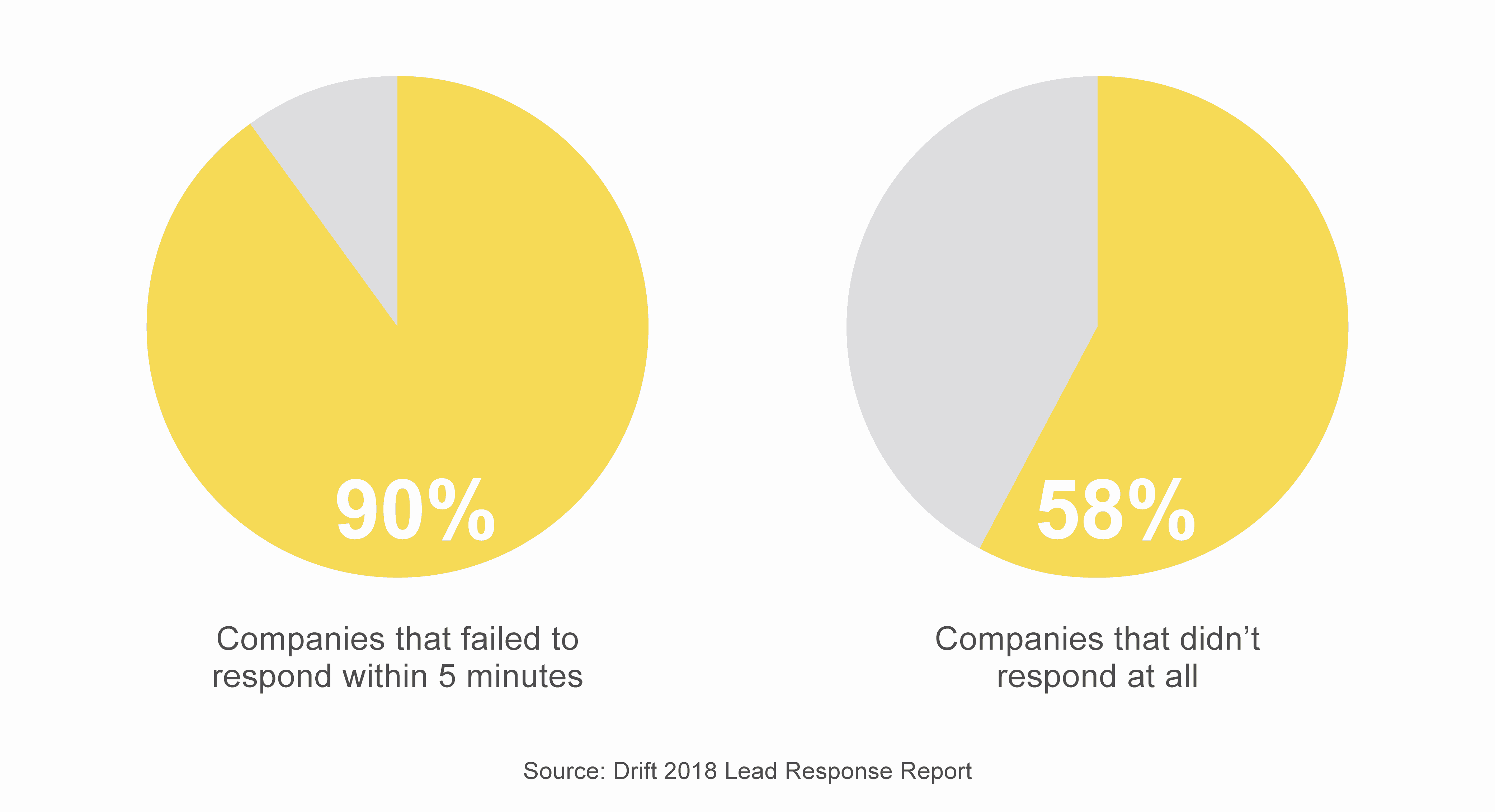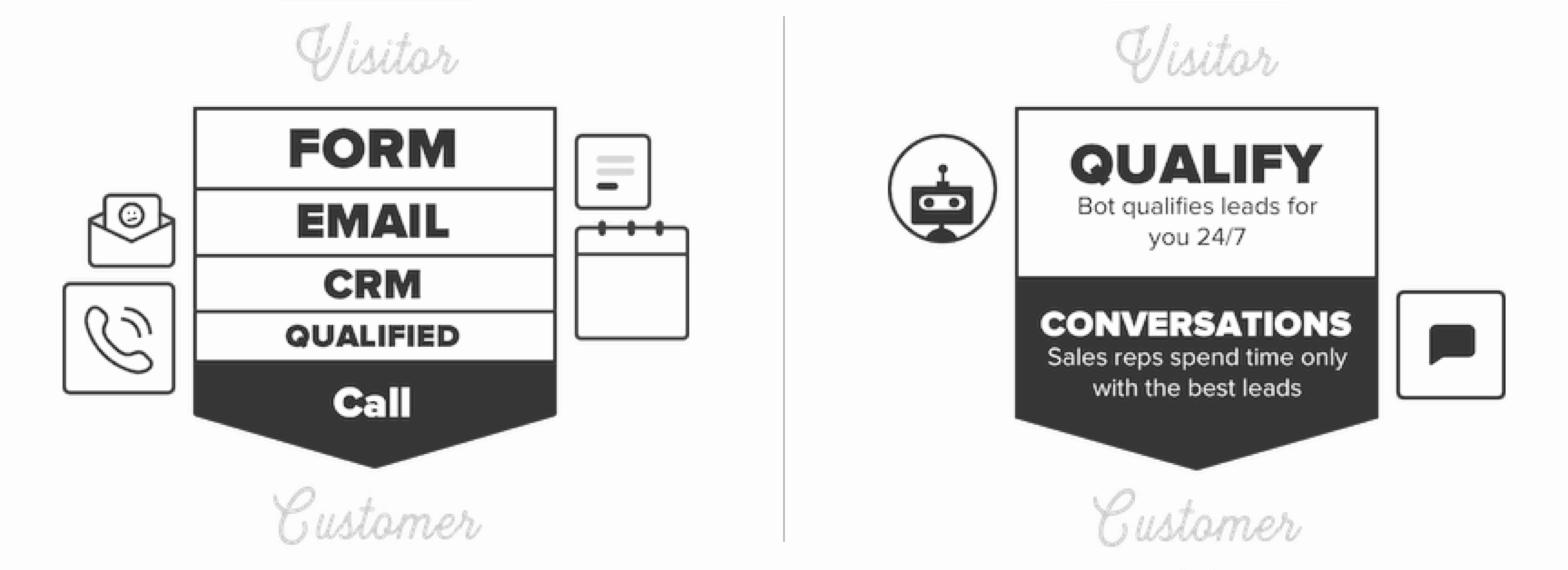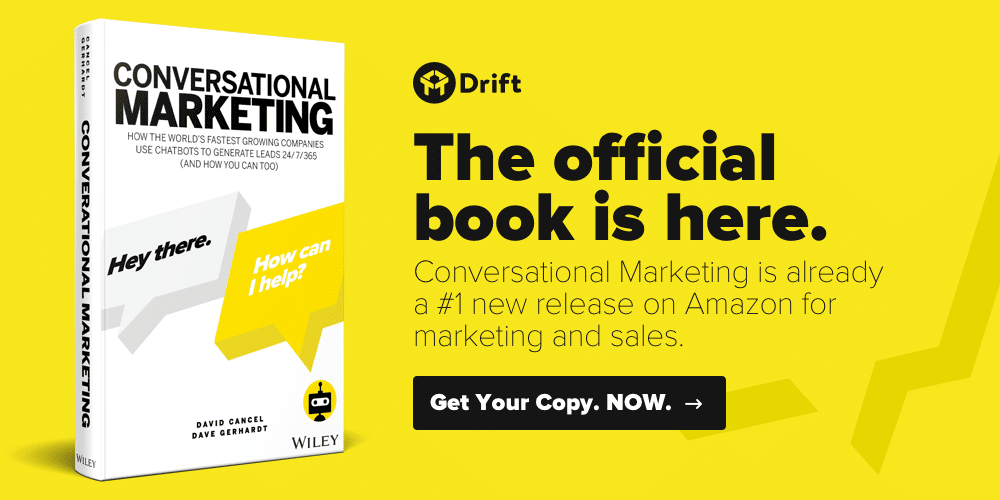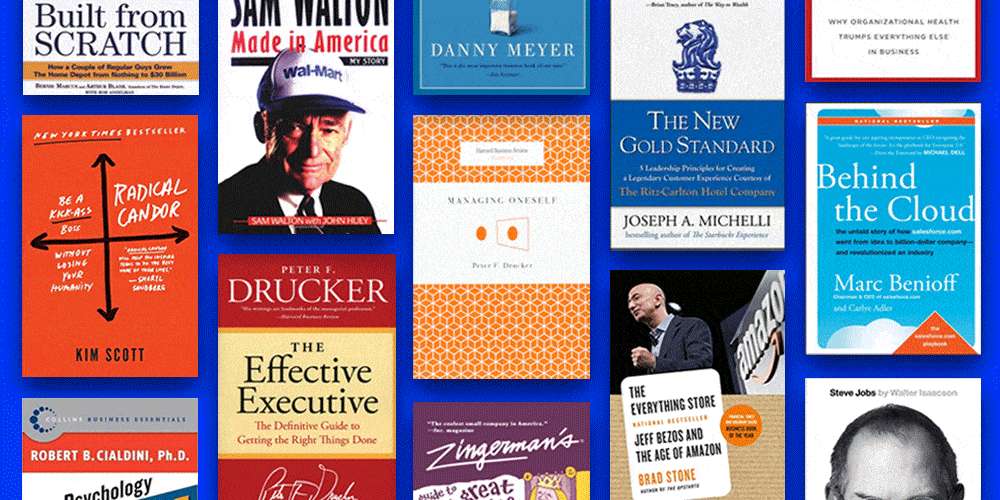
Editor’s Note: The following is an excerpt from Conversational Marketing: How the World’s Fastest Growing Companies Use Chatbots to Generate Leads 24/7/365 (and How You Can Too).
This book, written by Drift CEO, David Cancel, and VP of Marketing, Dave Gerhardt, forms the basis for Conversational Marketing as a practice. And shares insider strategies for implementing Conversational Marketing in a rapidly evolving sales and marketing landscape. You can order your copy of Conversational Marketing today here.
Read on for more insights from chapter one ?
—
Imagine seeing an advertisement for a new store that’s just opened in your neighborhood, but when you walk into that store, there’s no one there to greet you. In fact, there are no employees there at all. No salespeople walking the floor. No clerks behind the counters. And what makes the situation even more puzzling is that all of the store’s shelves are empty. There are no actual products that you can sample or try out, only pictures and descriptions.
At first glance, this appears to be a store—a store that you just saw an advertisement for a few minutes ago, mind you—that won’t let you buy anything.
But then you see it: Way in the back, there’s an old, dusty table, and on that table is a pen and a clipboard. “Ready to buy?” the form on the clipboard says. “Just fill this out and we’ll follow up with you later.”
“But what if I’m ready to buy now?” you ask aloud to no one.
58% of B2B Websites Are “Empty Stores”…Is Yours One of Them?
The above scenario sounds ridiculous because it absolutely is ridiculous. No brick-and-mortar store would pay for ads and generate buzz only to ignore potential customers once they showed up. Unfortunately, that’s exactly what most business-to-business (B2B) and software-as-a-service (SaaS) companies have been doing with their websites. According to eMarketer, B2B companies ended up spending a collective $4.6 billion on ads that drove people to their websites in 2018. Yet a majority of these companies are treating their websites like “empty stores.”
Instead of greeting visitors when they drop by our websites, we’ve been ignoring them. Instead of offering visitors assistance in real time (while they’re already right there and clearly interested), we’ve been making them fill out forms and wait. Worst of all, even when people do take the time to fill out forms, they’re not guaranteed to get a response. In a study we did at Drift, which looked at the websites of 512 B2B companies, we found that 58% of companies never followed up with website visitors who filled out forms and tried to get in touch with sales.
By sticking to the old marketing and sales playbook (see Figure 1.1), we’ve been forcing potential customers into an overly complex buying process. It’s a process that fails to acknowledge the fundamental shift that’s happened in how people prefer to buy.

Today, half of all B2B customers expect a company’s website to be helpful, while more than a third of customers expect a company’s website to be the most helpful channel they use during the buying process, according to research from BCG. So why are so many of us still treating our websites like empty stores? In doing so, we’re letting potential customers (and potential revenue) slip through the cracks.
The Solution: Add Real-Time Messaging to Your Website
By adding a messaging or “live chat” tool to your website, you can start greeting your website visitors in real time when they drop by. You can let people know, up front, that your website is not just another empty store.
Setting up a simple welcome message that lets people know you’re available to answer their questions is a great place to start. And best of all, it doesn’t require a ton of work. (I’ve seen teams get up and running, and start having conversations, in less than five minutes.)
In addition to helping you provide a better buying experience on your website, so you can catch those leads who are slipping through the cracks, messaging offers another huge advantage for marketing and teams: It allows you to capture, qualify, and connect with leads faster. Here’s why that’s so important today.
90% of B2B Companies Don’t Respond to Leads Fast Enough…Do You?
In a world of infinite supply, where customers have come to expect real-time responses as the default, companies no longer have the luxury of being able to make people wait. They can no longer control when a sale happens. Instead, marketing and sales teams need to be ready to help out at a moment’s notice, as soon as someone has a question. Otherwise, that person might end up in the arms of a competitor.

A study from InsideSales.com, published in the Harvard Business Review, found that waiting five minutes to respond to a new lead resulted in a 10x drop in the likelihood of being able to connect and follow up with that lead. After ten minutes, there’s a 400% drop in the odds of qualifying the lead. In other words, the longer you wait to respond after someone reaches out, the less likely it is that that person will convert. And for best results, companies should be staying below the five-minute mark.
Unfortunately, in the same Drift study where we looked at the 512 B2B companies, we found that 90% of companies failed to respond to sales inquiries within that five-minute sweet spot (see Figure 1.2).
This isn’t too surprising when you take into account that just 15% of the companies we looked at were using real-time messaging on their websites. But even if you do use real-time messaging, there’s no guarantee that you’ll be able to respond to every lead within five minutes. After all, there are only so many hours in a day, and there are only so many employees available to respond to people. So, what do you?
The Solution: Use Artificial Intelligence to Provide 24/7 Service
There’s been a lot of hype surrounding artificial intelligence (AI) and chatbots over the past few years. At one extreme, you have people who are worried that AI will take over the world—that intelligent machines will eventually come to replace humans in nearly every field and industry. At the other extreme, you have people who think intelligent machines are useless curiosities, and that they are more likely to distract and confuse potential customers than help them.
The truth, of course, lies somewhere in the middle. Our philosophy at Drift has been to use AI—specifically, intelligent chatbots—only for those tedious, repetitive tasks that AI is particularly well-suited for. The idea isn’t to replace human marketers and salespeople, it’s to supplement their efforts. And when it comes to responding to new leads as quickly as possible, 24/7, there’s no denying the effectiveness of intelligent chatbots.
Without having to write a single line of code, marketers and salespeople can now add chatbots to their websites that can provide answers to common questions, route visitors to the right people and departments, ask qualifying questions, and schedule meetings for sales reps. By automating these tasks, chatbots enable marketers and salespeople to focus more of their time on tasks that require a human touch, like answering complex product questions and building rapport with new leads. So even though you’re outsourcing some of the work to chatbots, the end result is a more human buying experience.
81% of Tech Buyers Don’t Fill Out Forms…Are You Still Using Them?
One of the key reasons why today’s B2B buying experience has become overly complex and unnecessarily slow is our reliance on lead capture forms. Pick up any book on B2B marketing and sales (excluding this one) and chances are there will be a section on setting up and optimizing lead capture forms and the landing pages they appear on. In fact, forms have become such an integral part of the traditional marketing and sales playbook that it can be hard for teams to even imagine how they could ever generate and qualify leads without them. (I know this first-hand because I watched my own marketing and sales teams go through it.)
For years, lead forms have been the engines powering our lead generation and lead qualification efforts. But today, the reality is that lead forms are no longer as effective as they once were. According to a survey conducted by LinkedIn, 81% of tech buyers don’t fill out forms when they encounter gated content—they’d rather go look for that information elsewhere than go through the hassle of filling out a form. Bearing that in mind, it probably won’t come as too much of a surprise to learn that the average conversion rate for landing pages these days is just 2.35%, according to Search Engine Land.
The underlying problem: While lead forms present a simple and scalable way for companies to capture and qualify leads, they completely ignore the preferences and expectations of the customer. By forcing buyers to share personal information in exchange for content and/or access to a sales rep’s time, we’re behaving as if there are no other resources or companies out there that those buyers can turn to (which obviously isn’t the case). And by forcing buyers to wait for follow-ups, assuming we even take the time to follow up at all, we’re ignoring the fact that today’s buyers have come to expect real-time, on-demand responses when they engage with businesses.
Today, lead forms act as roadblocks in the buying process, slowing down sales cycles and putting a damper on customer experience. So why are so many of us still sticking to this “forms and follow-ups” approach? What alternative do we have?
The Solution: Replace Forms with Conversations
By using a combination of real-time messaging and chatbots on your website, you can easily replace lead capture forms with conversations. For example, while it’s been common practice to add calls-to-action (CTAs) to the bottoms of blog posts that direct visitors to landing pages, where they can then fill out forms in order to download “premium” content (like ebooks or white papers), you can now create CTAs that initiate real-time conversations—either with actual people, if they’re available, or with chatbots, which have your back when no one’s around.
Best of all, when using conversations instead of forms, you don’t need to send people away from the blog posts they’re already reading, or the pages they’re already on, in order to move them further down the sales funnel. Instead, you can engage with visitors wherever they are on your website. Whether it’s a blog post, your homepage, your pricing page, or a “contact us” page, all you need to do is add a link that will trigger a real-time conversation.
Now, at this point, some of you might be thinking, “Wait . . . if I replace the forms on my website with conversations, how do I keep collecting all of the information I used to be collecting with forms? That’s information my company needs.” The answer is simple: You ask for it. The difference is that instead of learning about potential customers by forcing them to fill out static, impersonal lead forms, you can learn about them through having one-to-one conversations.
Even when it’s a chatbot doing the talking, the experience is light years ahead of what you can provide with forms, and you end up learning more about potential customers than you would have otherwise. To quote management consultant Brad Power, writing for the Harvard Business Review: “This is the strength of an AI agent that can elicit information like a person, rather than an analytics tool that simply finds patterns in the data it collects, like a machine.” (Power, 2017)

The bottom line: By replacing lead forms with conversations, you’re removing a roadblock from the buying process and replacing it with a fast lane for your best leads (see Figure 1.3).
—
Sorry to cut you off here, but we wanted to give you a taste of the first chapter of Conversational Marketing: How the World’s Fastest Growing Companies Use Chatbots to Generate Leads 24/7/365 (and How You Can Too), available for order now! Over the next few months, we’ll be dropping more chapters here on the blog.
Can’t wait? You can order your copy today here.






